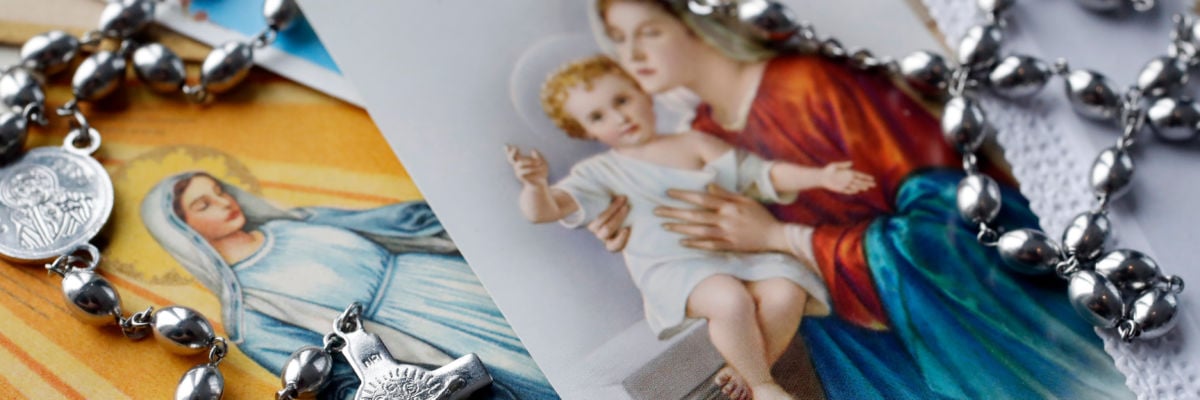
Years ago, when I was a student at Thomas Aquinas College in California, a young man who was a very serious Protestant started as a freshman there. He had been a nominal Catholic until college, when he left the practice of his faith to become a member of a very devout Protestant group. In fact, he wanted to become a Protestant minister, so he decided to go to a top-notch Catholic college, where he could learn all the best Catholic arguments in order to refute them. But with all that, he was an honest man, not someone with an axe to grind, and he was willing to listen to a reasonable argument.
His first semester, he was looking for a house for his family to move into. His saintly and über-competent wife took care of the kids while he lived temporarily in the dorms. There, he and I would get into knock-down, drag-out arguments about everything Catholic and Protestant (I had been a convert myself). We often stayed up till two or three in the morning. And on one occasion he made this objection: “My mother has all these pictures of Mary around the house, and only a couple of Jesus. That’s just completely wrong. It’s like Mary is more important than Jesus. What could Mary possibly have that Jesus doesn’t? Why would anyone pray to Mary, or any saint for that matter?”
I don’t remember exactly how I answered him on that occasion, besides telling him that I liked his mother very much, and she sounded like a very good Catholic. But I know what I would say now if asked that question.
Jesus once said, “He that believes in me will do the works that I do, and greater than these shall he do” (John 14:12). That is a remarkable statement, and it came true. For example, Jesus never healed anyone with his shadow, but Peter did (Acts 5:15). Jesus never converted 3,000 persons in one sermon, but Peter did (Acts 2:41). Some saints performed more remarkable resurrections than Jesus did. For example, St. Vincent Ferrer raised a child that had been totally dismembered.
Why is it that some saints performed greater miracles than Jesus did? Is it because Jesus could not do this himself? Clearly not. But for some reason, Jesus wanted to do more through Peter and his other disciples than directly himself. I can think of at least three reasons why God would choose to do greater works through the instrumentality of his saints than directly.
First, God uses creatures as his instruments in accomplishing his work in order to manifest his own power and wisdom. Take this simple example. Two artists each paint a painting. The first one has perfect instruments: an assortment of perfect brushes, perfect canvas, all the right colors, and so on. And so he paints a masterpiece. The second artist has one lousy brush, a bad canvas, and just a few primary colors. Yet he paints the same masterpiece. Who is the greater artist? Clearly the second artist is, since by painting the same masterpiece, but with defective instruments, he manifests the perfection of his ability as an artist. God likes to use defective instruments in order to show off his ability and his wisdom as an artist. St. Paul says as much when he asserts,
God chose the foolish of the world to shame the wise, and God chose the weak of the world to shame the strong, and God chose the lowly and despised of the world, those who count for nothing, to reduce to nothing those who are something, so that no human being might boast before God (1 Cor. 1:26-29).
Paul asserts the same principle when he says, “The Lord said, ‘My grace is sufficient for you, for power is made perfect in weakness.’ I will rather boast most gladly of my weaknesses, in order that the power of Christ may dwell with me” (2 Cor. 12:9). Once, St. Bernadette of Lourdes testified that if the Blessed Mother had found “a more ignorant and stupid child on earth,” she would have chosen her; but she couldn’t find one, so she chose Bernadette.
A second reason God wants to use creatures in order to communicate his goodness to us is that it puts us at ease. In the Old Testament, God appeared in a theophany on Mount Sinai. There he showed his majesty and power, but the result was not love, but fear and terror in the hearts of the Israelites:
When the people witnessed the thunder and lightning, the trumpet blast and the mountain smoking, they all feared and trembled. So they took up a position much farther away and said to Moses, “You speak to us, and we will listen; but let not God speak to us, or we shall die.” Moses answered the people: “Do not be afraid, for God has come to you only to test you and put his fear upon you, lest you should sin.” Still the people remained at a distance (Exod. 20:19-21).
God, like any father, does not want his children to remain at a distance, so he uses mediators to set us at ease. The people were able to somehow communicate with God through Moses. Later on, God would himself become man and use the created instrument of his sacred humanity to set us at ease, coming in the form of a baby, and later under the form of bread. For who could be frightened of a little child or a piece of bread?
God did this knowing full well that familiarity breeds contempt, but he was willing to allow himself to be treated by us with contempt for the sake of having us draw closer to him. The humility of God is unfathomable. Often too, we feel afraid to approach Christ directly, but when we think of his mother or one of the saints who are mere men like us, we are set at ease. This is what the Lord himself prophesies in the prophet Hosea: “I will draw them with the cords of Adam, with the bands of love” (11:4).
Related to this second reason is a third reason God prefers to use his saints as instruments to communicate grace. The facile question, “What would Jesus do?” does not always give us a clear indication of how we ought to act in the here and now. Jesus was a man. How can a woman relate to everything he did? Jesus was a first-century Jew from Palestine. How can a twenty-first-century American imitate him in every respect? Most importantly, Jesus was God, so there are some things he did and said that we just can’t imitate.
But every saint, being an instrument of the Holy Spirit, lived out the gospel in the concrete circumstances of his life in a perfect or near perfect way. Each one is like a perfect living out of the commandments incarnated in a new time and place and circumstances, closer to our own.
This makes it much easier to know how to act. Some saints were scholars, like St. Thomas Aquinas; some were jovial, like St. Philip Neri; some were diocesan priests, like St. John Vianney; some were laymen, like St. Pier Giorgio Frassati; some were nuns, like St. Teresa of Avila; some were wives and mothers, like St. Monica; and so on. Each gives us a more concrete example of how to follow Christ in our particular vocations and circumstances.
Besides this, if I am looking for an example of repentance, it will be hard to follow Jesus’ life, since he never had to repent. But it will be much easier to follow St. Peter or St. Mary Magdalene. Thus, we read in the scriptures that not only should we imitate Christ, but also his saints: “We wanted to present ourselves as a model for you, so that you might imitate us” (2 Thess. 3:9).
I don’t think a theology that denies that God generally prefers to use instruments to cause grace and salvation can stand in the face of revelation or of reason. God wants to encourage us to go to him through his saints. And to do this, he more quickly and readily answers our prayers and gives us greater gifts if we come to him through them: “They shall do greater works than I.”
That’s why I’m okay with the pious Catholic mother having more images of the Blessed Virgin Mary than of Jesus. It’s not because she loves Mary more than Jesus. It’s because she has confidence that God wants to give her more if she comes to him with and through Mary.
By the way, that young man I told you about eventually gave up his plans to become a Protestant minister. He came back to the Church and now has eleven beautiful children. He was even selected by his classmates to be the valedictorian. He spent most of his talk encouraging devotion to the Blessed Mother.
This article is an excerpt from Fr. Sebastian Walshe’s fantastic book Secrets from Heaven. The article has three “reasons,” but the book has five, including the “perhaps most profound” one. To get the full story, buy Secrets from Heaven today at the Catholic Answers shop.



